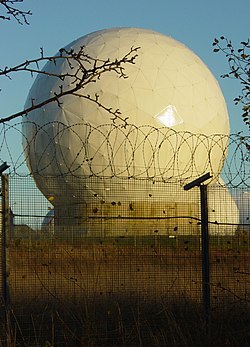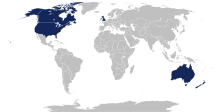ECHELON
From Wikipedia, the free encyclopedia

ECHELON is a name used in global media and in popular culture to describe a signals intelligence (SIGINT) collection and analysis network operated on behalf of the five signatory states to the UK-USA Security Agreement (Australia, Canada, New Zealand, the United Kingdom, and the United States, known as AUSCANZUKUS).[1] It has also been described only as the software system which controls the download and dissemination of the intercept of commercial satellite trunk communications.[2]
The system has been reported in a number of public sources.[3] Its capabilities and political implications were investigated by a committee of the European Parliament during 2000 and 2001 with a report published in 2001,[4] and by author James Bamford in his books on the National Security Agency of the United States.[2]
In its report, the European Parliament states that the term ECHELON is used in a number of contexts, but that the evidence presented indicates that it was the name for a signals intelligence collection system. The report concludes that, on the basis of information presented, ECHELON was capable of interception and content inspection of telephone calls, fax, e-mail and other data traffic globally through the interception of communication bearers including satellite transmission, public switched telephone networks and microwave links. The committee further concluded that "the technical capabilities of the system are probably not nearly as extensive as some sections of the media had assumed".[4]
Bamford describes the system as the software controlling the collection and distribution of civilian telecommunications traffic conveyed using communication satellites, with the collection being undertaken by groundstations located in the footprint of the downlink leg.
Contents[hide] |
[edit] Organization
| UKUSA Community |
|---|
The UKUSA intelligence community is assessed by the European Parliament to include the signals intelligence agencies of each of the member states - the National Security Agency of the United States, the Government Communications Headquarters of Britain, the Communications Security Establishment of Canada, the Defence Signals Directorate of Australia, and the Government Communications Security Bureau of New Zealand. The EP report concludes that it seems likely that ECHELON is a method of sorting captured signal traffic, rather than a comprehensive analysis tool.[4]
[edit] Capabilities
The ability to intercept communications depends on the medium used, be it radio, satellite, microwave, cellular or fiber-optic.[4] During World War II and through the 1950s, high frequency ("short wave") radio was widely used for military and diplomatic communication[5], and could be intercepted at great distances.[4] The rise of geostationary communications satellites in the 1960s presented new possibilities for intercepting international communications. The report to the European Parliament of 2001 states: "If UKUSA states operate listening stations in the relevant regions of the earth, in principle they can intercept all telephone, fax and data traffic transmitted via such satellites."[4]
The role of satellites in point-to-point voice and data communications has largely been supplanted by fiber optics. As of 2006, 99 percent of the world's long-distance voice and data traffic is carried over optical-fiber.[6] The proportion of international communications accounted for by satellite links is said to have decreased substantially over the past few years in Central Europe to amount to between 0.4 and 5%.[4] Even in less developed parts of the world, communications satellites are used largely for point-to-multipoint applications, such as video.[7] Thus the majority of communications cannot be intercepted by earth stations, but only by tapping cables and intercepting line of sight microwave signals, which is possible only to a limited extent.[4]
One approach is to place intercept equipment at locations where fiber optic communications are switched. For the Internet, much of the switching occurs at a relatively small number of sites. There have been reports of one such intercept site, Room 641A, in the United States. In the past, much Internet traffic was routed through the U.S. and the UK; this is less true today, with, for example, 95 percent of intra-German Internet communications being routed via the DE-CIX Internet exchange point in Frankfurt in 2000.[4] Thus for a worldwide surveillance network to be comprehensive, either illegal intercept sites would be required on the territory of friendly nations or cooperation of local authorities would be needed. The report to the European Parliament points out that interception of private communications by foreign intelligence services is not necessarily limited to the American or British foreign intelligence services.[4]
Most reports on ECHELON focus on satellite interception, with no credible evidence for other capabilities.[8]
[edit] Controversy
Reportedly created to monitor the military and diplomatic communications of the Soviet Union and its Eastern Bloc allies during the Cold War in the early sixties, today ECHELON is believed to search also for hints of terrorist plots, drug dealers' plans, and political and diplomatic intelligence. But some critics claim the system is also being used for large-scale commercial theft, international economic espionage and invasion of privacy.
British journalist Duncan Campbell and New Zealand journalist Nicky Hager asserted in the 1990s that the United States was exploiting ECHELON traffic for industrial espionage, rather than military and diplomatic purposes.[9] Examples alleged by the journalists include the gear-less wind turbine technology designed by the German firm Enercon[10][11] and the speech technology developed by the Belgian firm Lernout & Hauspie.[12] An article in the Baltimore Sun reported in 1995 that French aerospace company Airbus lost a $6 billion contract with Saudi Arabia in 1994 after the NSA reported that Airbus officials had been bribing Saudi officials to secure the contract.[13][14]
In 2001, the Temporary Committee on the ECHELON Interception System recommended to the European Parliament that citizens of member states routinely use cryptography in their communications to protect their privacy.[4]
Bamford provides an alternate view, highlighting that legislation prohibits the use of intercepted communications for commercial purposes, although does elaborate on how intercepted communications are used as part of an all-source intelligence process.
[edit] Hardware
According to its website, the National Security Agency is "a high technology organization... on the frontiers of communications and data processing". In 1999 the Australian Senate Joint Standing Committee on Treaties was told by Professor Desmond Ball that the Pine Gap facility was used as a ground station for a satellite based interception network. The satellites are claimed to be large radio dishes between 20 and 100 meters across, parked in geostationary orbits. The original purpose of the network was to monitor the telemetry from 1970s Soviet weapons, air defense radar, communications satellites and ground based microwave communications.[15]
[edit] Name
The European Parliament's Temporary Committee on the ECHELON Interception System stated: "It seems likely, in view of the evidence and the consistent pattern of statements from a very wide range of individuals and organisations, including American sources, that its name is in fact ECHELON, although this is a relatively minor detail."[4] The U.S. intelligence community uses many code names (see, for example, CIA cryptonym).
Margaret Newsham claims that she worked on the configuration and installation of some of the software that makes up the ECHELON system while employed at Lockheed Martin, for whom she worked from 1974 to 1984 in Sunnyvale, California, USA and in Menwith Hill, England, UK.[16] At that time, according to Newsham, the code name ECHELON was NSA's term for the computer network itself. Lockheed called it P415. The software programs were called SILKWORTH and SIRE. A satellite named VORTEX would intercept communications. An image available on the internet of a fragment apparently torn from a job description shows Echelon listed along with several other code names.[17]
[edit] Ground stations
Some of the ground stations suspected of belonging to or participating in the ECHELON network include:
[edit] Likely satellite intercept stations
The following stations are listed in the European Parliamentary report (p.54 ff)[4] as likely to have a role in intercepting transmissions from telecommunications satellites:
- Hong Kong (since closed)
- Australian Defence Satellite Communications Station (Geraldton, Western Australia)
- Menwith Hill (Yorkshire, UK) Map
- Misawa Air Base (Japan)
- GCHQ Bude, formerly known as GCHQ CSO Morwenstow, (Cornwall, UK)
- Pine Gap (Northern Territory, Australia - close to Alice Springs) Map
- Sugar Grove (West Virginia, US)
- Yakima Training Center (Washington, US) Map
- GCSB Waihopai (New Zealand)
[edit] Other potentially related stations
The following stations are listed in the EP report (p.57 ff) as ones whose roles "cannot be clearly established":
- Ayios Nikolaos (Cyprus - UK)
- Bad Aibling Station (Bad Aibling, Germany - US) - moved to Griesheim in 2004[citation needed]
- Buckley Air Force Base (Denver, Colorado, US)
- Fort Gordon (Georgia, US)
- Guam (Pacific Ocean, US)
- Kunia (Hawaii, US)
- Leitrim (south of Ottawa, Ontario, Canada)
- Lackland Air Force Base, Medina Annex (San Antonio, Texas, US)
[edit] See also
| Wikimedia Commons has media related to: Echelon |
- ANCHORY SIGINT intercept database
- Frenchelon
- Onyx (interception system), the Swiss "Echelon" equivalent
- Mass surveillance
- FRA law, the Swedish law allowing it's government to process data sent from or into the country
[edit] Further reading
- Bamford, James; The Puzzle Palace, Penguin, ISBN 0-14-006748-5; 1983
- Hager, Nicky; Secret Power, New Zealand's Role in the International Spy Network; Craig Potton Publishing, Nelson, NZ; ISBN 0-908802-35-8; 1996
- Keefe, Patrick Radden Chatter: dispatches from the secret world of global eavesdropping; Random House Publishing, New York, NY; ISBN 1-4000-6034-6; 2005
[edit] Notes
- ^ "AUSCANNZUKUS Information Portal". auscannzukus.org.. Retrieved on 2008-03-27.
- ^ a b Bamford, James; Body of Secrets, Anchor, ISBN 0-385-49908-6; 2002
- ^ One of the earliest was a New Statesman article entitled Someone's Listening in 1988
- ^ a b c d e f g h i j k l m Schmid, Gerhard (2001-07-11). "On the existence of a global system for the interception of private and commercial communications (ECHELON interception system), (2001/2098(INI))" (pdf - 194 pages). European Parliament: Temporary Committee on the ECHELON Interception System. Retrieved on 2008-03-27.
- ^ The Codebreakers, Ch. 10, 11
- ^ "NSA eavesdropping: How it might work". Retrieved on 2006-08-27.
- ^ "Commercial Geostationary Satellite Transponder Markets for Latin America : Market Research Report". Retrieved on 2006-08-27.
- ^ For example: "Nicky Hager Appearance before the European Parliament ECHELON Committee" (April 2001). Retrieved on 2006-07-02.
- ^ "Nicky Hager Appearance before the European Parliament ECHELON Committee" (April 2001). Retrieved on 2006-07-02.
- ^ Die Zeit: 40/1999 "Verrat unter Freunden" ("Treachery among friends", German), available at archiv.zeit.de
- ^ Report A5-0264/2001 of the European Parliament (English), available at European Parliament website
- ^ "Amerikanen maakten met Echelon L&H kapot". [1] (2002-03-30). Retrieved on 2008-03-28. (Google's translation of the article into English).
- ^ "BBC News". Retrieved on 2006-08-27.
- ^ "Interception capabilities 2000". Retrieved on 2006-08-27.
- ^ Commonwealth of Australia, Official Committee Hansard (9 August 1999). JOINT STANDING COMMITTEE ON TREATIES, Reference: Pine Gap.
- ^ Elkjær, Bo; Kenan Seeberg (1999-11-17). "ECHELON Was My Baby", Ekstra Bladet. Retrieved on 17 May 2006. “Unfortunately, I can’t tell you all my duties. I am still bound by professional secrecy, and I would hate to go to prison or get involved in any trouble, if you know what I mean. In general, I can tell you that I was responsible for compiling the various systems and programs, configuring the whole thing and making it operational on main frames"; "Margaret Newsham worked for the NSA through her employment at Ford and Lockheed from 1974 to 1984. In 1977 and 1978, Newsham was stationed at the largest listening post in the world at Menwith Hill, England...Ekstra Bladet has Margaret Newsham’s stationing orders from the US Department of Defense. She possessed the high security classification TOP SECRET CRYPTO."
- ^ "Names of ECHELON associated projects – image without any context". Retrieved on 2006-08-27.








